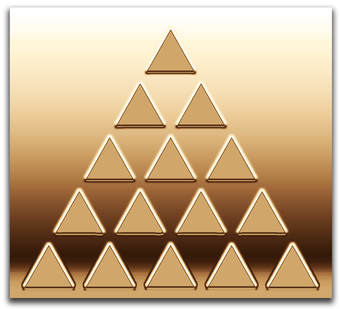
If the interval - the resulting combination of 2 notes - is considered the foundation of the melodic line, then the triad is certainly the backbone of Western harmonic function.
Because triads have such strong tonal gravity, they are a powerful means of creating colorful melodic lines – both “inside” or “outside” of a given key center.
It's therefore of primary importance for the improviser to be comfortable and proficient with all aspects of triads, including their inversions and permutations. This should lead to the eventual understanding of how they function, not only as the bottom part (root, 3rd & 5th) of an extended chord (7th, 9th, 11th & 13th), but as the extensions themselves.
Although this might sound like a pretty basic topic to an advanced improviser, it's always a good idea to review the subject from time to time, as well as to include triad sequences as part of a daily practice or warm-up routine.
It's amazing what one might (re)discover.
- Major (C – E – G, or Maj 3rd + min 3rd)
- Minor (C – Eb – G, or min 3rd + Maj 3rd)
- Augmented (C – E – G#, or Maj 3rd + Maj 3rd)
- Diminished (C – Eb – Gb, or min 3rd + min 3rd)
Triads are expressed in 3 forms, or inversions. The inversions of a C Maj triad are:
- Root Position (C – E – G)
- 1st Inversion (E – G – C)
- 2nd Inversion (G – C – E)
Ex. 1.
The numbers under the notes of each arpeggio, indicate the interval number, relative to the root (ie. CEG = 1-3-5). A Major triad will always be some combination of the numbers 1,3 & 5.
The underlined numbers represent notes that are below the root (which is always “1”) and is part of my developing shorthand, which attempts to illustrate the position and octave of both the 3rd and 5th of the triad, relative to the root. This helps to identify, in numbers, a triad's actual permutation.
Ex. 2.
This complete line itself is worth checking out, not just because the lone Db triad is the only one not underscored, but also because as the root movement and triads descend chromatically, the line ascends - employing different inversions and permutations along the way – as repeating patterns manifest.
In this volume, the Maj triad exercises and sequences are all laid out according to their interval cycle - semitone, whole tone, minor & Major 3rd, perfect 4th & 5th, and tritone.
Ex. 3. - “Star Eyes” - the last four bars. Descending triads in semitones.
In bar #3, for the sake of melodic and harmonic continuity, C minor & B minor triads are employed over the ii-V7 (F min7 – Bb7alt) resolving to Eb.
Ex. 4. - Maj. Triads in Whole Tones ii-V7 Sequence – Triad Pairs.
While the matter of Triad Pairs / Hexatonics is a study all its own, the sequences found throughout this book are a worthy primer toward further investigation of the subject.
Ex. 5. - Maj. Triads in minor 3rds - ii-V7 Sequence
Ex. 6. - Common Tones
- The Root of a C Maj triad
- The Major 3rd of an Ab Maj triad
- The 5th of an F Maj triad
Yagapriya is a 7-note scale - Melakarta #31 in Carnatic Music. It's been the subject of previous blog posts and a dedicated Shortbook™, as well. It is also clearly exhibited in the Neo-Riemannian “Tonnetz”, a geometric representation dating back to the 18th century, which depicts relationships between triads, keys and their voice leading.
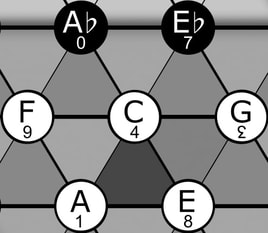
C-E-G is connected by the triangle at the bottom right.
C-Eb-Ab is connected by the triangle at the top.
C-F-A is connected by the triangle at the bottom left
C-Eb-E-G F-Ab-A-C = “C Yagapriya”.
How this South Indian scale, which is relatively unknown and unused in Western music, could have been featured so prominently in an 18th century German geometric chart showing triadic relationships, is pretty amazing!
As mentioned previously, triads are the strongest expression of tonality in Western music. What might seem to be an elementary concept is really anything but. Command of triads is essential for anyone hoping to be a competent improviser.
“Triadicisms - Volume One: Major Triad Workout”, this month's Shortbook™ is both a great place to start and / or to keep digging deeper.
B. Stern






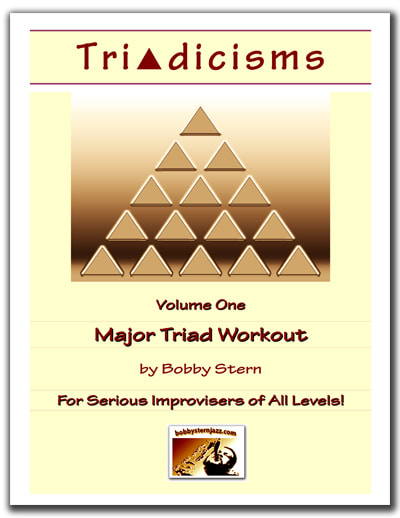
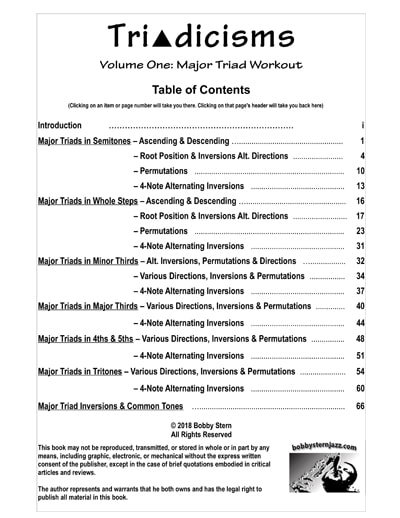
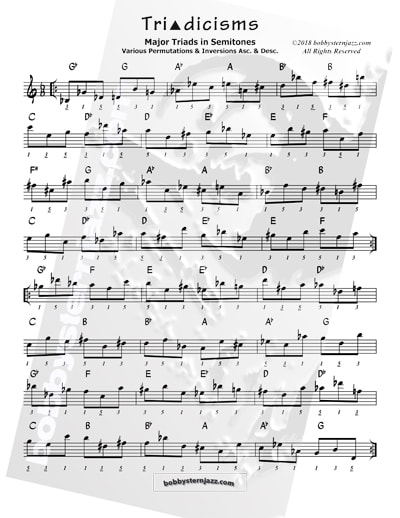
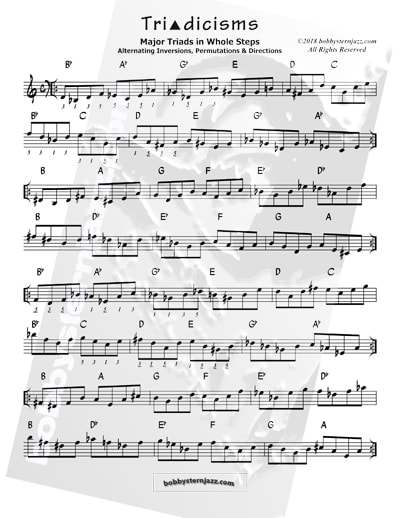

 RSS Feed
RSS Feed









